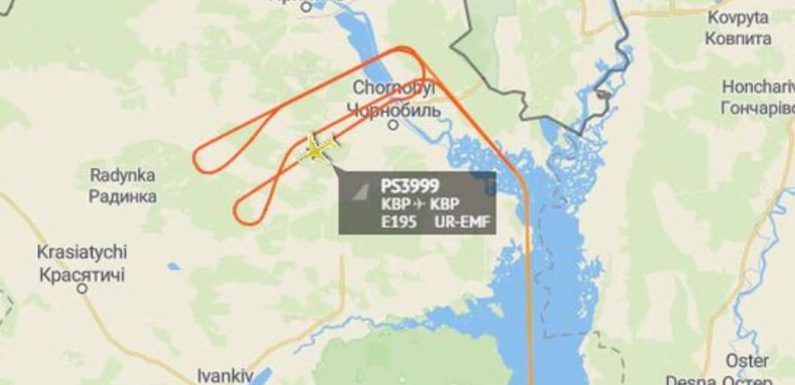
Last year saw a resurgence in scenic flights or, as they were quickly dubbed, “flights to nowhere”.
Qantas piloted circular flights over Uluru, and similar sightseeing expeditions were launched over Borneo and even Antarctica. However, “nowhere” doesn’t get more literal than a flight over a nuclear exclusion zone.
Ukraine International Airlines has flown a sold-out flight over the Chernobyl nuclear power plant to mark the disaster’s 35th anniversary.
RELATED: Frightening story of the ‘Black Bird of Chernobyl’
The ghost town of Pripyat, 35 years after the nuclear disaster. Picture: Genya Savilov/AFPSource:AFP
“Passengers of the flight will be able not only to see Kiev and Chernobyl from the most unusual angles and the minimum allowable height — 900 meters, but also to deepen their knowledge about the causes and consequences of the Chernobyl accident,” the national airline said.
Timed to coincide with the anniversary, passengers were treated to an apocalyptic vision of a place where human activity was accidentally wiped out.
RELATED: Creepiest pictures of nuclear town
The flight lasted just one and a half hours. Picture: RadarBoxSource:Supplied
On a 90-minute tour from the wings of an Embraer 195 passenger jet, the plane visited the Chernobyl site and evacuated village of Pripyat.
It might seem like the natural apocalyptic apex of a trend that took off during a pandemic, however, the scenic flight is a continuation of other dark tourism trends in Ukraine.
While Chernobyl was already the site of fringe tourism activities, in recent years visitor numbers have grown. A hit TV drama and several documentaries saw tourist numbers double since 2018.
People take pictures at the bottom of the disused Soviet-built over-the-horizon radar (OTH) system Duga-1 near Chernobyl. Picture: Genya Savilov/AFPSource:AFP
In 2019 the government in Kiev announced intentions to make the site a national park, open to visitors. Now the country’s flag carrier airline has bought into the dark tourism trend.
“Our tourism is unique, it is not a classic concept of tourism,” Bohdan Borukhovskyi, Ukraine’s deputy environment minister told the Associated Press.
“This is an area of meditation and reflection, an area where you can see the impact of human error, but you can also see the human heroism that corrects it.”
Officials hope that this level of interest will continue, or grow, once the global pandemic has receded.
RELATED: Residents return to Chernobyl after 33 years
An ferris wheel in an abandoned amusement park in the ghost town of Pripyat. Picture: Sergei Supinsky/AFPSource:AFP
Though not everyone is pleased with this prediction. Abandoned infrastructure and derelict buildings will not be able to cope with a much greater number of visitors.
“Chernobyl should not become a wild playground for adventure hunters,” said Ukrainian Culture Minister Oleksandr Tkachenko.
“People should leave the exclusion zone with the awareness of the historical memory of this place and its importance for all mankind.”
There are plans for the exclusion zone to be recognised by UNESCO World Heritage, but for now there is a pause to visitor numbers amid the pandemic.
Men buy souvenirs and coffee in a souvenirs booth at the Dytyatky control point at an entrance to the Chernobyl exclusion zone. Picture: Sergei Supinsky/AFPSource:AFP
On April 26, 1986, a reactor in the Chernobyl nuclear power plant caught fire, beginning the most drastic nuclear disaster recorded.
There were 100,000 people evicted from the surrounding area, creating a 2600 square kilometre exclusion zone. The rest of the country and Kiev would not hear about the disaster for days – until clouds of radioactivity began billowing over Europe, and Soviet authorities could no longer hide the scale of the disaster.
There were big plans to mark the 35th anniversary with 120,000 predicted visits. Yet all of these were thrown into disarray by the pandemic.
Chernobyl plant employees light candles and lay flowers at the monument to Chernobyl victims in Slavutych, the city where the power station’s personnel lived, during a memorial ceremony on the 35th anniversary on April 26. Picture: Sergei Supinsky/AFPSource:AFP
Yesterday, the event was marked by a military service at the Chernobyl catastrophe memorial in Kiev, with attendees masked and distanced as a precaution against COVID-19.
The nuclear disaster has seeped into every aspect of the culture in northern Ukraine.
The reactor even appears in images on the wall of an Orthodox chapel in Slavutych. Hosting a remembrance service over the weekend, attendees were watched over by the icon of a ghostly messiah in front of the reactor fire.
A woman attends a memorial in Minsk to mark the 35th anniversary of the disaster on April 26. Picture: AFPSource:AFP
An explosion of interest in 2019 has been followed by an eerie quiet, after disruptions caused by coronavirus-related travel restrictions.
Now the site is abandoned again by all but a brave few and the robots, still dismantling the reactors inside the giant Chernobyl sarcophagus.
The clean up of inside the reactor aims to be completed by 2064.
– With Associated Press
This article originally appeared on the New Zealand Herald and was reproduced with permission
trending in travel
Source: Read Full Article

















